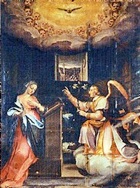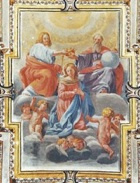

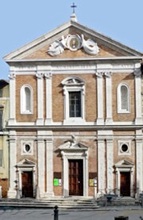
Bishop Cardinal Fulvio della Corgna called the Jesuits to Perugia in 1551 and provided accommodation for them in Palazzo Vescovile. Bishop Ippolito della Corgna gave them the site of the old church of Sant' Andrea in 1561. (Cardinal Francesco Armellini had acquired the site in 1520 for a college that he proposed to build, but his death in 1527 had led to the abandonment of the project).
A community of Capuchin nuns that had built the church and nunnery of Santa Chiara in 1552 came under their spiritual guidance in 1556.
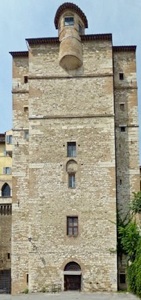
The Jesuits were expelled following the suppression of their order in 1773 and replaced by a community of Barnabites from Sant’ Ercolano. They in turn were expelled in 1810, and returned in 1837 to find the church in a poor state of repair. They were expelled again in 1860. The ex-convent (to the right of the church) was incorporated into the complex of the Tribunale di Perugia (the Perugian law courts and associated offices) at that time. The Barnabites took refuge in the palace of Bishop Gioacchino Pecci for about ten years, until a few of them managed to return to il Gesù. The Barnabites still officiate at the church.
The upper part of the façade of the church was finally completed in 1934 by the architect Eduardo Vignaroli, in accordance with a detail of a panel from the ex-convent that is now in the Galleria Nazionale (see below).
A fire in 1989 devastated the nave of the church, and destroyed its gilded ceiling. Most of the altarpieces in the aisles were also lost. The church was restored as far as possible in 2001.
Interior
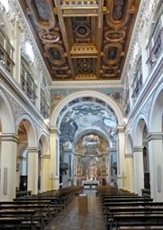
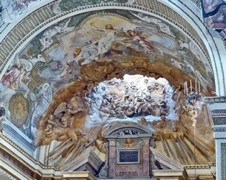
The interior has a wide central nave with side aisles, a rectangular presbytery and a tiny pensile apse. Light from the window in the apse floods down on a terracotta representation of angels in high relief adore a representation of the holy name of Jesus. Other gilded angels suspended in the apse point the way to Heaven. The fresco (17th century) on the ceiling depicts the Resurrection of Christ.
The gilded ceiling (1576) was repaired using original fragments after the fire of 1989.
Circumcision of Christ (1575?)
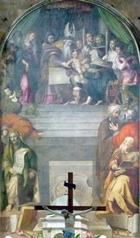
The altarpiece depicts the ceremony of circumcision, with two prophets below:
-
✴Jeremiah on the left; and
-
✴Habakkuk on the right.
The inscription between the prophets reads “ANO IVBILEI MDLXXV”.
There is some doubt about the date of the work and its author:
-
✴It has been attributed to Durante Alberti and dated to the time of the Jubilee in 1575.
-
✴However, other writers (including the guide referenced below) attributed it to the Flemish artist Michele Desubleo (1602-76). If this is correct, the painting must have been executed after 1630, when Desubleo arrived in Italy. (See the page on Durante Alberti for the relevant references).
Scenes from the life of Joshua (1666-7)
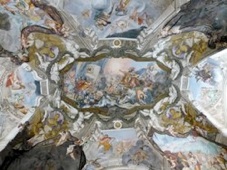
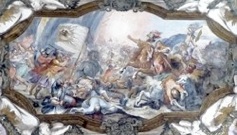
These documented frescoes by Giovanni Andrea Carlone, il Genovese are on the ceiling of the crossing.
Panels (17th century)
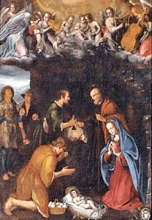
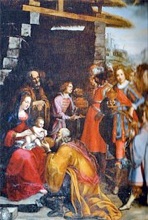
These two panels in the presbytery, which are by Stefano Amadei, depict:
-
✴the Adoration of the Shepherds; and
-
✴the Adoration of the Magi.
Oratories
The church stands on the edge of an artificial terrace, with its pensile apse above three oratories that are built one above the other (illustrated above). These can be seen from terrace of the covered market, or by leaving Piazza Matteotti along Via Alessi and turning right into Via Angusta.
The oratories were used by three lay confraternities, each of which was defined by the social class of its members, starting from the top:
-
✴the Congregazione dei Nobili, for nobles;
-
✴the Congregazione degli Artisti, for artisans; and
-
✴the Congregazione dei Contadini, for farmers or peasants.
Only the last of these has its own entrance from outside the church. The other two can be reached from the stairs behind the door at the end of the left aisle (just before the crossing).
Oratorio dei Nobili (1596)
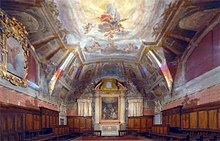
Annunciation (late 16th century)
God the Father and Angels (17th century)
These frescoes by Cesare Sermei and Girolamo Martelli are on the ceiling.
Panels (17th century)
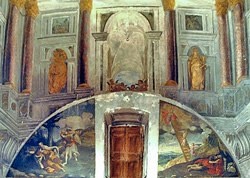
The quadrant panels on the back wall, which are signed by Bartolomeo Giorgetti, depict:
-
✴Elijah fed by an angel; and
-
✴the dream of Jacob.
Frescoes (18th century)
The perspectival frescoes in the upper registers of the walls (some of which can be seen in the photograph above) of the oratory are attributed to Pietro Carattoli.
Oratorio degli Artisti (1603)
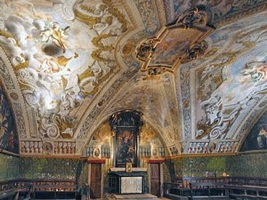
The altar (17th century), which is decorated by inlaid ivory and ebony, is by Fortunato Tedesco.
Assumption of the Virgin (17th century)
This panel on the altar is by Francesco Amadei.
Coronation of the Virgin (17th century)
Frescoes (17th century)
The other frescoes on the ceiling, which also have Marian iconography, are by Antonio Maria Fabrizi and Giovanni Andrea Carlone, il Genovese.
Panels (ca. 1665)

These lunette-shaped panels on the left wall, which are initialled by Pietro Montanini and dated 166.., depict:
-
✴the Presentation of Christ at the Temple (on the left); and
-
✴the Visitation.
Birth of the Virgin (ca. 1665)

This lunette-shaped panel on the right wall is by Paolo Gismondi.
Oratorio dei Contadini (1603)
Frescoes (1746)
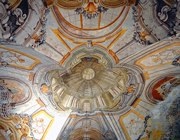
The frescoes on the ceiling of the oratory, which are signed by Pier Francesco Colombati and dated by inscription, depict biblical figures set in perspectival architecture that includes a fictive lantern at the centre.
Bequest of Simonetto Anastagi
An inscription (18th century)on the counter-façade of the church records the important bequest of works of art that the Perugian noble, Simonetto Anastagi made to the Collegio dei Gesuiti in 1602. This bequest included the following:
Madonna della Ciliegia (of the cherry) (1573)
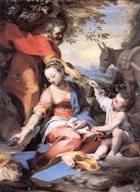
The panel actually depicts the Holy Family resting during their flight to Egypt: it takes its usual title from the fact that St Joseph is depicted picking cherries and giving them to the baby Jesus. It is one of a series that derive from a prototype (now lost) that Barocci painted for Duke Guidobaldo II della Rovere, Duke of Urbino: Duke Guidobaldo commissioned this prototype in 1570 as a present to Lucrezia d' Este on the occasion of her wedding to his son, the future Duke Francesco Maria II della Rovere.
Holy Family and the Rest on the Flight to Egypt (ca. 1550)
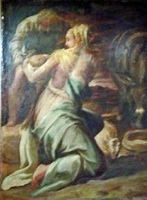
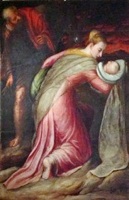
These two panels, which are attributed to Orazio Alfani, were recorded in the 18th century on the counter-façade of the church. Cards attached to them recorded that they formed part of the Anastagi bequest. They entered the Galleria Nazionale in 1863.
Presentation of Jesus (ca. 1580)
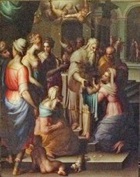
Other Art from the Complex
Madonna and Child with saints (1610-7)
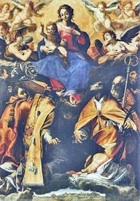
The panel depicts the Madonna and Child in Glory, above a cityscape of Perugia, with:
-
✴SS Herculanus, Constantius and Laurence, the patron saints of Perugia; and
-
✴SS Dominic, Augustine and Francis, the patrons of the Perugian confraternities that commissioned the panel.
Miniatures (ca. 1600)
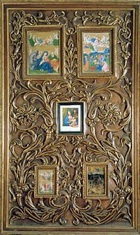
-
✴the Holy Family with angels;
-
✴the Madonna and Child in glory with saints;
-
✴the Holy Family;
-
✴the Assumption of the Virgin; and
-
✴the Martyrdom of St Stephen.
They are now in the Galleria Nazionale.
Commissioning of the Chiesa del Gesù (ca. 1600)
This panel from the convent, which is now in the deposit of the Galleria Nazionale, is attributed alternatively to Giulio Caporali or to the Venetian Pietro Malombra. It depicts Cardinal Fulvio della Corgna delivering the design for the new church to the Jesuits in 1561. The depiction of the facade of the church here was used in 1934, when the upper part of the facade was finally completed.
Read more:
C. Corbetta (Ed), A. Bertiniand and A. Manzana, “La Chiesa del Gesu di Perugia: Storia e a Arte”, (2008 ) Perugia (available in the church)
Return to Monuments of Perugia.
Return to Walk II.
